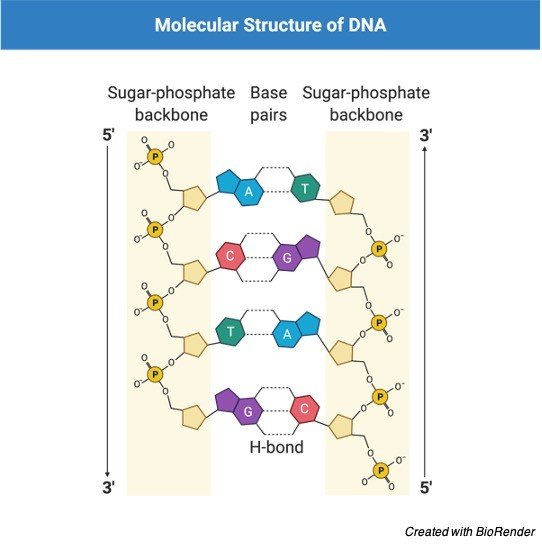Table of Contents
Genetic Material Definition
Cellular material capable of self-propagation and variation that plays a key role in shaping the structure and type of cell substances. A gene, a portion of a gene, a set of genes, a DNA (or RNA) molecule, a fragment of DNA (or RNA), a group of DNA molecules (or a group of RNA molecules), or an organism’s whole genome can constitute the genetic material of a cell. Depending on whether the organism is a prokaryote or a eukaryote, it can be located in the nucleus, mitochondria, or cytoplasm.
What is Genetic Material?
Genetic material is the cell’s hereditary component. It houses all of an organism’s distinct data. It’s also known as DNA (deoxyribonucleic acid) or RNA (ribonucleic acid) (ribonucleic acid). Where can you find genetic material? DNA is found in the cytoplasm of prokaryotes such as bacteria. DNA is present in the nucleus of eukaryotes such as plants and animals (nuclear DNA) and, to a lesser extent, in extranuclear locations such as mitochondria (containing mtDNA) and chloroplasts (containing chloroplast DNA) (containing cpDNA).
In the somatic cells of a multicellular creature, genetic material regulates the organism’s makeup and is similar. The genetic material can multiply within the cell, resulting in new cells with the same genetic material as the parent. Plasmids are plasmids, which are genetic materials.
Plasmids are pieces of genetic material located outside of bacteria’s chromosomes. They’re distinct, circular, supercoiled, and a fraction of the size of chromosomal genetic data. Non-essential characteristics like antibiotic resistance and the generation of toxins are frequently encoded in plasmids. Plasmids may multiply without the help of the cell. Conjugative plasmids can be passed across bacteria, causing new characteristics to emerge in the recipient bacterial cell.
A gene, a segment or set of genes, or even the whole genome might be found in genetic material. The three forms of genetic material are DNA, RNA, and genes.
Genetic information is transmitted from one generation to the next during reproduction. It might be done in a sexual or asexual way. The “clone” obtains genetic information that is identical to its parent in asexual reproduction. In sexual reproduction, on the other hand, the “offspring” inherits genetic material from both their father and mother. As a result, the offspring’s genetic material is not a carbon duplicate of its parents’.
Genetic Material Structure
Scientists investigated the structure and function of genetic material and discovered that it is stored in chromosomes. Because chromosomes include both proteins and DNA, it was unclear whether the genetic information was carried by the proteins or the DNA at first. Because proteins lack the most crucial characteristic of genetic material, replication, Hershey and Chase’s studies demonstrated that DNA, not proteins, constituted the genetic material.
The genetic material of a human cell is in the form of double-stranded DNA molecules that create a double helix structure. It is made up of two DNA strands formed by a sequence of nucleotides.
The two strands split during cell replication, resulting in the formation of two new DNA molecules. The original DNA molecule and the freshly duplicated DNA molecule are identical.
Guanine (G), cytosine (C), adenine (A), and thymine (T) are the four nucleotides that make up DNA.

On the other hand, C is coupled with G, while A is paired with T, creating a base. A nucleotide is formed when a base is joined to a phosphate molecule and a ribose sugar.
In humans, DNA is present in the nucleus as chromosomal linear strands. In bacteria, on the other hand, it exists as a solitary genophore. Structural proteins bind to chromosomal DNA to create chromatins which compress, organise, and regulate DNA strand accessibility.
In eukaryotes, chromatin is typically made up of nucleosomes containing DNA segments coiled around histone proteins. A genome is an organism’s whole set of genetic material.
Some viruses have RNA as their genetic material. It is made up of a single strand with a phosphate group, sugar, and nucleotides on one end. Furthermore, the RNA strand’s bases are as follows:
Guanine (G), cytosine (C), adenine (A), and uracil (U), with uracil replacing thymine in DNA. The base pairs of RNA are identical to those of DNA, with the exception that adenine and uracil are coupled.
Genetic Material Function
The genetic material is crucial since it contains all of the information about the creature. Individuals’ genetic composition differs due to variations in the sequence and order of the nucleotides that make up DNA.
In order to keep genetic material secure, DNA strands are extremely condensed and ordered in the cell. It should, however, be accessible to the cell for use as a template in biological activities like protein synthesis.
The cell uses the DNA strand as a guide to synthesizing proteins, since DNA is utilised to make messenger RNA, which is complementary to one of the DNA strands.
Ribosomal RNA then translates the messenger RNA into proteins made up of different amino acids. The genetic code is the sequence of amino acids.
Characteristic of Genetic Material
Every cell has genetic information. It contains all of the organism’s data. It changes depending on the organism. It regulates several activities within the cell, as well as cell replication and the creation of new cells. It also takes into account the diversity of organisms.
DNA is the genetic substance found in all cells. It is handed down through the generations via DNA. Previous generations are linked to an individual through genetic information. Individual traits like hair and skin colour, as well as other invisible or recessive qualities, are inherited by genes.
Some genetic alterations (mutations) may impact an individual’s genetic material and may be passed down to the next generation. Other alterations may not impact genetic material and, as a result, are not passed down to kids. The DNA sequence is currently being utilised to develop new treatments for hereditary disorders that are difficult to treat.
Genetic Material Citations
Share












